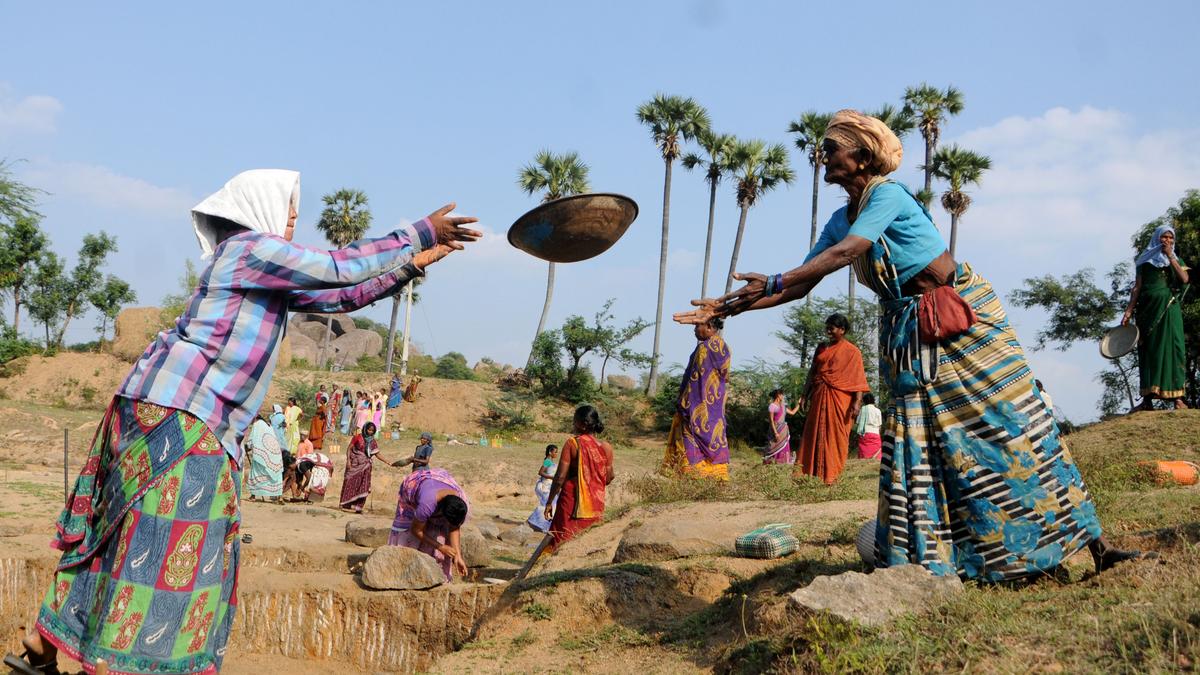
Parliament proceedings | Centre has no role to play in MNREGA job card deletions, says Govt.
The Hindu
Union Rural Development Ministry clarifies Centre's role in MNREGA job-card deletions, denies correlation with Aadhaar, addresses budget concerns.
Centre has no role in MNREGA job-card deletions and it is the function of the State government based on five factors, Union Rural Development Ministry said in a reply to oral questions in Lok Sabha on Tuesday (December 3, 2024) during the Question Hour. The government also denied any correlation between the mandatory imposition of Aadhaar based payment system for MNREGA wages and high rate of job-card deletions, insisting that the Aadhaar seeding has been done only to ensure transparency.
Also read: MGNREGS demand not a real indicator of rural distress: Economic Survey
Congress MP and party general secretary K.C. Venugopal pointed out that in the last four years 10.43 crore MNREGA workers have been deleted from the programme. Calling it shocking he said that in 2021-22 1.49 crores were removed which jumped by 247% in 2022-23 with the deletion of 5.53 crore workers. Terming the jump “shocking”, he asked whether this surge coincided with Union Rural Development Ministry’s directions making Aadhaar based payments mandatory for paying MNREGA workers.
Replying to the question Minister of State and TDP leader Chandra S. Pemmasani said that Aadhaar seeding of the job card is aimed at increasing transparency and is not an obstacle. He said that the job cards are deleted based on five factors - fake card, duplicate card, if the beneficiary has moved from one panchayat to another, or the beneficiary has expired, or the beneficiary no longer wants to work under the programme or the area has been reclassified as urban. “Deletion of job cards is state’s responsibility and centre has no role in it,” Mr. Pemmasani said. He also asserted that 99% of all job card holders have Aadhaar seeding.
The Minister also answered Mr. Venugopal, Congress MP Sasikanth Senthil, DMK MP T. R. Baalu and others questioned the reduction in budget, saying that the scheme is a demand-based programme and the Centre increases allocation based on the State government’s demand. Hitting back at the Congress, he cited the budgetary figures from United Progressive Alliance (UPA) regime, claiming that in successive budgets between 2009-10 to 2012-13 the budgetary estimate was lower than the actual spending the previous financial year.
Mr. Venugopal countered by saying that the five parameters listed by the minister do not explain a deletion of 10.43 crore workers. Your explanation, he said, is “insulting” the labourers and does not match with the ground realities. Also delay in wage payments or payments under other heads of the programme, Mr. Venugopal said it defeats the very purpose of the programme. Mr. Pemmasani, pressing on further, said, every year on an average 50 to 60 lakh new job cards are added. He explained that between 2021-22 to 203-24 the number of job-card holders have remained more or less the same. “In 2021-22 there were 9.58 crore active job card holders, this number dipped by roughly ten lakh in 2022-23 reaching to 9.49 crores but the next year in 203-24 it was up by roughly 20 lakh settling at 9.79 crores,” Mr. Pemmasani said. He further added that 57% of the rural development budget goes to MNREGA.
Mr. Senthill also pointed out that in the last few years, the budgetary allocation has been consistently lower than the revised budget of the previous financial year. “How can the government be so blind and insensitive?” he asked. He also raised the issue of mobile application based attendance system which is coming in the way of registering attendance for many. The minister Mr. Pemmasani insisted that the budget has kept up with demands from the States. He cited regional differences in these demands. “ In 2022-23 Uttar Pradesh, a state with a 30 crore population asked for ₹10,000 crore, while Tamil Nadu with a population of seven crore asked for ₹2,500 crores more,” he pointed out.

The Karnataka government has drafted a comprehensive master plan for the integrated development of Kukke Subrahmanya temple, the State’s highest revenue-generating temple managed by the Hindu Religious Institutions and Charitable Endowments Department. The redevelopment initiative is estimated to cost around ₹254 crore and aims to enhance infrastructure and facilities for devotees.












